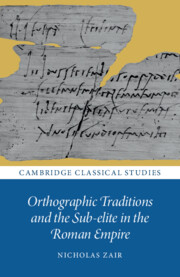This book uses the standard conventions of epigraphy, phonology and phonetics, and Indo-European linguistics. Unfortunately, these to some extent overlap so that the same symbols may be used for more than one purpose; in other cases the ‘same’ element may be represented in more than one way. I draw attention to this here, in the hope of avoiding confusion for the reader: which convention applies should in every case be clear from context.
Where inscriptional forms are being represented, [ ] surround missing letters, { } surround letters engraved in error, < > surround letters supplied by the editors to replace those omitted or engraved in error, and ( ) enclose the expansion of an abbreviation.
In quoted editions of literary texts, [ ] surround parts of the text that should be removed and < > a portion of text supplied by the editor.
When individual graphemes are being discussed, they are enclosed within < > (graphemes from the Latin alphabet are not italicised when between angled brackets); on the rare occasions when the actual symbol used for the grapheme is being discussed, this is not enclosed within angled brackets.
Phonemes and sequences of phonemes are enclosed within / / and phones within [ ] (phonetic transcription is as broad as possible). Phonemes and phones are represented according to the conventions of the IPA alphabet, as laid out in the IPA Handbook (The International Phonetic Association 1999). Reconstructed forms are preceded by an asterisk *,Footnote 1 and use the standard orthography of historical linguistic and Indo-Europeanist literature. There are three discrepancies between the two that I flag up here. The first is that the labiovelar and palatal approximants (glides) written /w/ and /j/ ([w] and [j]) respectively in the IPA are written *-u̯- and *-i̯- in reconstructions; as the second element of tautosyllabic diphthongs, these are written /u/ and /i/ in phonemic/phonetic representation (e.g. /ai/ [ai]), but as *-u̯- and *-i̯- in reconstructions (e.g. *-ai̯-). The second is that the vowels of the Latin phoneme system that derive from Proto-Indo-European *e and *o are represented as /ɛ/ and /ɔ/ respectively. The third is that long vowels in Latin words and reconstructions are marked by use of a macron, thus: nōtum; in the IPA they are marked by use of the symbol ː, thus: /nɔːtum/. I mark long (and, where occasionally relevant, short) vowels in Latin words when I am referring to that word as a lexeme; long vowels are not marked when quoting actual forms found in inscriptions or other texts, nor when I am using a Latin word borrowed into English.
Given that much of this book is devoted to counting particular spelling features, I have preferred to use numerals rather than words even in running text, since this makes it easier to quickly identify the key information in the text.



